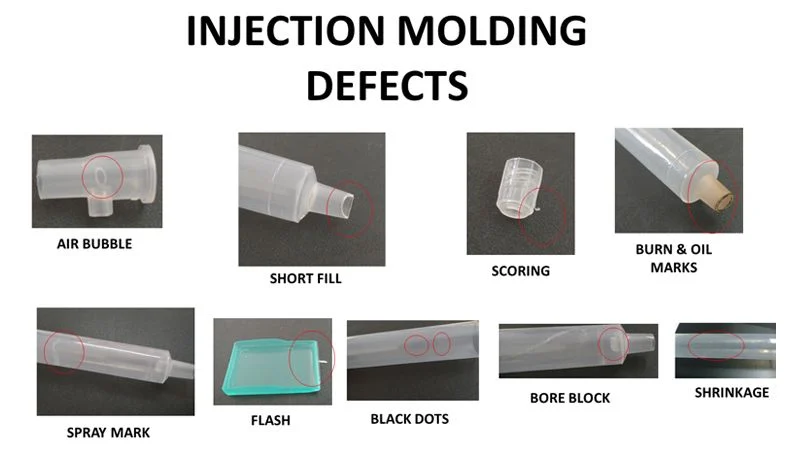The production of injection molding products requires the use of injection molding molds. Under normal circumstances, the surface of plastic products produced by this injection molding method has good gloss and color, but sometimes some shortcomings will inevitably occur. In addition to the material problems of the plastic itself, colorants and the gloss of the mold surface, what other reasons can cause such an impact in injection molding processing?
(1) The mold finish is poor, there are rust stains on the surface of the cavity, etc., and the mold exhaust is not good.
(2) If there is a problem with the pouring system of the mold, the cold slug well should be enlarged, the runner should be enlarged, the main channel should be polished, the runner and the gate should be polished.
(3) The material temperature and mold temperature are low. If necessary, local heating of the gate can be used.
(4) The injection molding processing pressure is too low, the speed is too slow, the injection time is insufficient, and the back pressure is insufficient, resulting in poor compactness and a dark surface.
(5) The plastic must be fully plasticized, but the degradation of the material must be prevented, the heating must be stable, and the cooling must be sufficient, especially for thick walls.
(6) To prevent cold material from entering the workpiece, use a self-locking spring or reduce the nozzle temperature if necessary.
(7) Too much recycled material is used, the plastic or colorant is of poor quality, mixed with water vapor or other impurities, and the lubricant used is of poor quality.
(8) The clamping force must be sufficient.
When plastic injection molding is processed and produced, there are often many factors that will affect the quality of the product. To sum up, there are mainly the following four points:
1. Plastic materials
The complexity of plastic material properties determines the complexity of the injection molding process. The performance of plastic materials varies greatly due to different varieties, different brands, different manufacturers, and even different batches. Different performance parameters may lead to completely different molding results.
2. Injection temperature
The melt flows into the cooled cavity and loses heat due to heat conduction. At the same time, heat is generated due to shearing. This heat may be more or less than the heat lost by thermal conduction, mainly depending on the injection molding conditions. The viscosity of the melt becomes lower as the temperature increases. In this way, the higher the injection temperature, the lower the viscosity of the melt, and the smaller the required filling pressure. At the same time, the injection temperature is also limited by thermal degradation temperature and decomposition temperature.
3. Plastic injection molding processing temperature
The lower the plastic injection molding processing temperature, the faster the heat is lost due to thermal conduction, the lower the temperature of the melt, and the worse the fluidity. This phenomenon is particularly evident when lower injection rates are used.
4. Injection time
The impact of injection time on the plastic injection molding process is reflected in three aspects:
(1) If the injection time is shortened, the shear strain rate in the melt will also increase, and the injection pressure required to fill the cavity will also increase.
(2) Shortening the injection time will increase the shear strain rate in the melt. Due to the shear thinning characteristics of the plastic melt, the viscosity of the melt will decrease, and the injection pressure required to fill the cavity will also decrease.
(3) Shorten the injection time, the shear strain rate in the melt increases, the greater the shear heat, and at the same time less heat is lost due to heat conduction. Therefore, the temperature of the melt is higher and the viscosity is lower. The injection required to fill the cavity is Stress should also be reduced. The combined effect of the above three conditions makes the curve of the injection pressure required to fill the cavity appear “U” shaped. That is, there is an injection time when the required injection pressure is small.
The difference between precision injection molding and ordinary injection molding lies in the word precision, which means higher requirements on plastic products, smaller tolerances, and more beautiful appearance.
Overview of precision injection molding
The basis of precision injection molding is the accuracy of injection molded products, that is, the dimensional tolerance, geometric tolerance and surface roughness of the product. There must be many related conditions for precision injection molding, and the most essential are the four basic factors of plastic materials, injection molds, injection molding processes and injection molding equipment. When designing plastic products, engineering plastic materials should be selected first, and engineering plastics that can be used for precision injection molding must use materials with high mechanical properties, dimensional stability, good creep resistance, and resistance to environmental stress cracking. Secondly, an appropriate injection molding machine should be selected based on the selected plastic material, finished product dimensional accuracy, piece weight, quality requirements and expected mold structure. During the processing process, the factors that affect precision injection molded products mainly come from the accuracy of the mold, injection shrinkage, and the change range of the environmental temperature and humidity of the product.
The impact of mold accuracy on precision injection molding
In precision injection molding, molds are one of the keys to obtaining precision plastic products that meet quality requirements. The molds used for precision injection molding should actually meet the requirements of product size, accuracy and shape. However, even if the accuracy and size of the mold are consistent, the actual size of the molded plastic products will be inconsistent due to differences in shrinkage. Therefore, effectively controlling the shrinkage rate of plastic products is very important in precision injection molding technology.
Factors affecting injection shrinkage
Whether the mold design is reasonable or not will directly affect the shrinkage rate of plastic products. Since the mold cavity size is calculated by adding the size of the plastic product to the estimated shrinkage rate, the shrinkage rate is recommended by the plastic manufacturer or the engineering plastics manual. A value within a range, which is not only related to the gate form, gate position and distribution of the mold, but also to the crystal orientation (anisotropy) of the engineering plastic, the shape and size of the plastic product, the distance to the gate and Location related. The main factors that affect the shrinkage of plastics include thermal shrinkage, phase change shrinkage, orientation shrinkage, compression shrinkage and elastic recovery, and these influencing factors are related to the molding conditions or operating conditions of precision injection molded products. Therefore, the relationship between these influencing factors and injection molding conditions and their apparent factors must be considered when designing the mold, such as injection pressure, cavity pressure and mold filling speed, injection melt temperature and mold temperature, mold structure and gate form and distribution. , as well as the influence of factors such as gate cross-sectional area, product wall thickness, reinforcing filler content in plastic materials, crystallinity and orientation of plastic materials. The influence of the above factors also varies due to different plastic materials, other molding conditions such as temperature, humidity, continued crystallization, internal stress after molding, and changes in the injection molding machine.
Effects of changes in ambient temperature and humidity of products
Because the injection molding process is a process of transforming plastic from solid (powder or granular) to liquid (melt) and then to solid (product). From pellets to melt, and then from melt to finished products, the process must go through the effects of temperature field, stress field, flow field, density field, etc. Under the combined action of these fields, different plastics (thermosetting or thermoplastic, crystalline or amorphous, reinforced or non-reinforced, etc.) with different polymer structural morphology and rheological properties. Any factors that affect the above “field” will definitely affect the physical and mechanical properties, size, shape, accuracy and appearance quality of plastic products.


